Many medications are more effective when given orally instead of in the water, especially when a bird is ill because an ill bird is unlikely to drink enough medicated water. The oral administration of liquid medications in poultry and other fowl is very easy to do, and when giving small quantities, it is very safe if the proper procedure is followed.
• How do I catch, carry, and hold my bird?
Chickens are easiest to catch at night when it's dark, but a net might be required to catch other fowl, or chickens during daylight. Bass Pro Shops carry landing nets of different sizes that work very well.
Do not carry a bird by its wings.
Never carry a bird upside-down by its legs.
• What should I wear?
Do wear a long sleeve shirt and pants. Gloves might be good to wear when handling roosters, ducks, geese, or peafowl.
• What tools do I need to dose orally, and where do I get them?
You will need a small needleless syringe(size 1 ml/cc) or an oral dosing syringe. They can be purchased online, at veterinarian offices, your feed store, and pharmacies carry oral dosing syringes for people. Larger 3 ml/cc syringes can be used, but the smaller 1 ml/cc is preferred. If you need to give more than 1 ml/cc, just prepare the number of syringes needed.
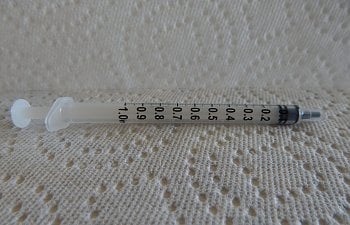
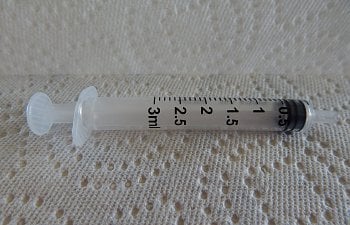
You will also need a scale. A kitchen scale works for most birds, but for larger birds, like waterfowl and peafowl, a bathroom scale might be better.
The easiest way to weigh a bird on a kitchen scale is to place the scale on your bathroom counter, turn the lights off, turn on the scale, then stand bird on the scale and take the reading.
When using a bathroom scale, weigh yourself holding the bird, then weigh just yourself. The difference between the two is the weight of your bird.
• How do I determine the dosage?
The dose depends on the medication, the weight of the bird, and what you are treating the bird for.
For dosing recommendations, try here: Emergencies / Diseases / Injuries and Cures
• How do I do it?
Pick a quiet spot away from other animals, bright lights, loud sounds, etc.
The bird should be held in an upright position close to the body of the person that is holding it with both wings and legs restrained. Never hold a bird on its back because it puts too much pressure on the bird's heart and lungs.
Monitor your bird for signs of stress during this process. If your bird starts to panic, pant, or turn blue/purple, set the bird down and let it relax.
Until you master the technique, it's best to have a helper to ensure the safety and proper medication of your bird.
1. Have your scale, medication(s), calculator, and syringe(s) ready.
2. Catch and weigh your bird.
3. Calculate the dose and prepare your syringe(s).
4. Catch and restrain the bird.
5. One person will hold the bird with it close to their body while restraining the bird's wings and legs while the other person gently holds the head still and opens the beak.
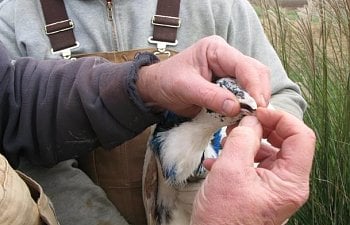
6. Once the beak is open, be sure that you understand where the medication-filled syringe should be inserted. The opening in the center at the back of the tongue is the entrance glottis, the entrance to the trachea, which leads to the lungs, nothing should ever go in there! If your bird accidentally aspirates a little, set it down so it can cough it out.
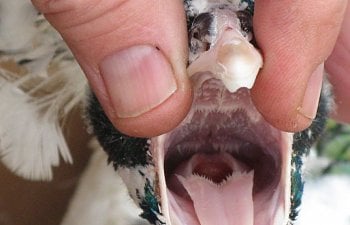
7. Gently insert the syringe along the right-hand side of the bird's tongue and inject the medication slowly to make sure that it does not spill over into the trachea.
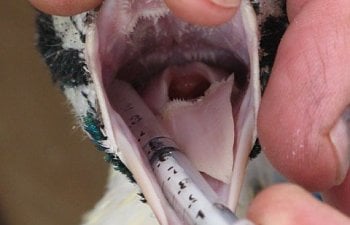
* Please note that the peafowl images are courtesy of Craig Hopkins of Hopkins' Alternative Livestock
Here is a good video that shows how easy it is to give oral medication:
References:
http://avianmedicine.net/wp/publication_cat/avian-medicine/
http://avianmedicine.net/wp/publication_cat/clinical-avian-medicine/
https://lafeber.com/vet/oral-drug-administration-in-birds/
https://lafeber.com/vet/tube-feeding-birds/
https://www.merckvetmanual.com/bird...eding-of-birds/giving-medication-to-pet-birds
http://www.dummies.com/home-garden/...to-give-your-chickens-a-physical-examination/
Technical Procedures for the Avian Patient by Amy B. Johnson, CVT
Disclaimer - Always best to consult with a vet, and please understand that I have no medical training!
.


